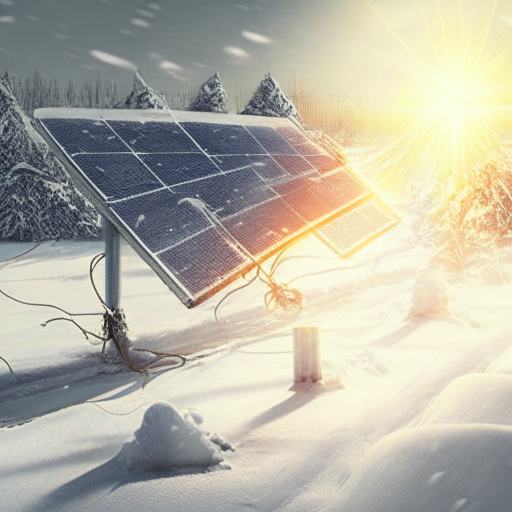Putting the Power of Solar Energy to Work in Extremely Cold Conditions
Because you are a survivalist, you are aware of the significance of being self-sufficient, particularly when confronted with harsh circumstances. When it comes to harnessing renewable energy solutions that are effective in cold areas, one of the most significant problems you encounter is. The freezing cold can be a strong foe, but there is no need to be afraid of it! This article will discuss the unrealized potential of solar power solutions in cold areas. We are going to unearth the keys to unlocking the power of solar energy even in the harshest of winters by taking a confident approach to the situation.

There are a lot of people who think that solar electricity can only be used in places that are warm and sunny. On the other hand, technological improvements have made it possible to harvest solar energy in regions with colder climates as well. Let us take a more in-depth look at the ways in which solar power solutions can thrive in extremely cold environments, as well as the ways in which you can make the most of this environmentally friendly and sustainable energy source.
First and foremost, it is essential to have a solid understanding that solar panels do not produce heat but rather energy from the sun’s rays. It is possible that cooler temperatures will have an effect on the output of solar panels; nevertheless, this does not mean that solar panels are rendered ineffective during the winter months. Through careful planning and the implementation of some creative ideas, it is possible to maximize the effectiveness of your solar power system, even in the coldest locations of the world.
When it comes to solar electricity in cold areas, the angle and orientation of the panels is one of the most important factors to take into consideration. You will be able to optimize the amount of sunshine that your solar panels receive throughout the day if you arrange them at the optimal angle. During the winter months, the sun’s path is lower in the sky; therefore, changing your panels to a steeper angle can ensure that they capture the maximum amount of sunlight by maximizing their efficiency. When the panels are oriented toward the south, they are able to collect sunlight more efficiently, which is especially beneficial during the winter months.
Snow accumulation is another difficulty that might arise in cold areas. The effectiveness of your solar panels can be greatly diminished if they are covered in a thick coating of snow. However, if you approach this challenge with self-assurance, you will be able to triumph over it. Installing snow barriers or heating elements on your solar panels is a straightforward option that may be implemented. Additionally, these modifications prevent snow from collecting or melting away, which guarantees that your solar panels will continue to generate electricity even in the midst of a snowfall. On the other hand, removing snow manually on a regular basis can also be an excellent method for maintaining the clarity of your panels.
The incorporation of battery storage systems is yet another cutting-edge approach to improving the efficiency of solar power in cold locations. Batteries give you the ability to store excess energy that you make during the day and then use it later on when there is less sunlight or when temperatures are lower. When the temperature is really low, battery storage becomes even more important because it guarantees a continuous supply of electricity even when there is a lack of sunlight. By making an investment in a battery system that is dependable, you can keep your energy independence and ensure that you are always ready for any situation that may arise.
In cold areas, it is necessary to select the appropriate type of solar panels in order to further optimize your solar power system with regard to efficiency. It is possible for certain panels to function more effectively at lower temperatures since they are specifically intended to perform in cold weather situations. It is possible that these panels feature additional insulation or advanced materials that prevent frost or ice from impairing their performance. By taking a confident approach, you will be able to select the panels that are most suited to meet the requirements of your chilly climate and optimize the amount of energy that you produce.
It is essential to ensure that your solar power system is installed by specialists who have prior experience working in cold climatic circumstances. This is in addition to the technical considerations that must be considered. The best practices for installation, maintenance, and troubleshooting can be provided by them, and they can provide significant insights and advice on these practices. Because of their knowledge, you will be able to guarantee that your solar power system will function at its highest level, even when exposed to extremely low temperatures.
To conclude, it is always a good idea to have a backup plan and to always be prepared when you have a survivalist attitude. At the same time as solar power has the potential to be dependable and effective in cold climates, it is absolutely necessary to have backup generators or alternate energy sources as a precautionary measure. The provision of this can serve as a safety net for you in the event that you experience prolonged periods of low sunlight or unexpected system malfunctions. You are able to improve your energy independence and resilience by combining solar power with other renewable energy solutions. This is true regardless of how severe the weather may be.
Climates that are warm and sunny are not the only places where solar energy can be used. Solutions that utilize solar electricity have the potential to flourish in even the coldest of conditions, provided that they are properly planned and technologically advanced. It is possible to realize the full potential of solar energy in extremely cold temperatures by modifying the angles of the panels, preventing snow accumulation, including battery storage systems, selecting panels that are appropriate for the environment, relying on skilled installation, and having backup plans. Your ability to embrace renewable energy and protect your survival in any environment can be achieved through an approach that is both self-assured and resourceful.
AI: The Ultimate Survival Companion
Artificial Intelligence: The Ultimate Survival Companion Imagine the following: You suddenly find yourself in the middle of an uninhabited wilderness area with no traces of human habitation anywhere in the vicinity. As the light goes down, a feeling of dread begins to take hold. Then, however, a little item that you had stashed away in […]



